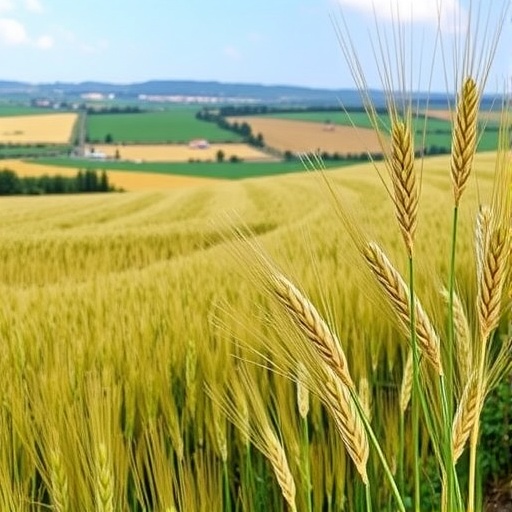In recent years, the quest for agricultural sustainability has become increasingly vital, especially in the context of climate change and food security. A new study focuses on the genetic diversity and population structure of a core collection of Mediterranean durum wheat accessions, which hold significant promise for breeding programs aimed at enhancing yield and resilience. This research not only underlines the genetic intricacies of durum wheat but also offers insights into conservation strategies for this essential staple crop.
The authors of the study, Laribi, Ben M’Barek, and Velasco-Cuervo, have utilized advanced genomic techniques, specifically DArTseq markers, to unravel the genetic makeup of these wheat accessions. This technology allows for a high-resolution analysis of genetic variation, providing a comprehensive understanding of the genetic landscape of durum wheat. By focusing on a core collection, the researchers aimed to identify and characterize the genetic resources that could be vital for breeding programs.
Durum wheat, primarily cultivated in the Mediterranean region, is renowned for its high protein content and gluten quality, making it a staple for pasta production. However, the genetic diversity within this crop has been under-explored, leading to a potential vulnerability in the face of pests, diseases, and changing climatic conditions. The current study seeks to address this gap by examining the genetic diversity that exists within the core collection of durum wheat accessions, offering a pathway for more resilient crop varieties.
One of the critical findings of this research is the identification of specific genetic variations tied to phenotypic traits, which could translate into practical applications in breeding programs. By correlating genetic markers to desirable traits, breeders can make informed decisions that enhance the nutritional quality and yield of durum wheat. This targeted approach could significantly contribute to improving food security, a pressing global challenge.
Furthermore, the study emphasizes the importance of preserving genetic diversity in durum wheat. As agricultural practices evolve and climate challenges intensify, maintaining a broad genetic base becomes crucial for developing varieties that can withstand adverse conditions. The DArTseq analysis not only highlights the existing variations but also serves as a foundation for future breeding initiatives that prioritize genetic diversity.
The implications of this research extend beyond the immediate agricultural context. The findings could influence policy-making in terms of conservation efforts for vital crops. By advocating for the protection of diverse genetic resources, this study contributes to a broader dialogue about sustainable agricultural practices and food production systems that are resilient to environmental changes.
In terms of methodology, the use of DArTseq markers represents a significant advancement over traditional genetic analysis techniques. This high-throughput sequencing technology generates a wealth of data, enabling researchers to perform a more nuanced analysis of genetic structures. The comprehensiveness of this data allows for better assessment of population structure and genetic relationships among durum wheat accessions.
Moreover, the study provides a case for the integration of genomic resources in traditional breeding programs. It showcases how modern plant genetics can align with age-old farming practices to enhance the sustainability of crop production. As farmers face increasing pressure from global changes, the melding of scientific research with traditional agricultural knowledge can yield significant benefits.
A noteworthy aspect of the study is its holistic approach to genetic analysis. By not only focusing on genetic differences but also contextualizing them within the framework of environmental challenges, the researchers illustrate the interconnectedness of genetics, agriculture, and the environment. This perspective is essential for crafting solutions that are not only scientifically sound but also socially responsible.
The team also highlights the need for collaborative efforts in the field of plant breeding. By sharing genetic data and resources among researchers, horticulturists, and farmers, the potential for creating robust and adaptable crop varieties increases significantly. This collaborative strategy focuses on collective goals, addressing broader challenges in food production and security.
In summary, this groundbreaking research sheds light on the genetic diversity of Mediterranean durum wheat in a way that could reshape future breeding practices. By employing cutting-edge technology to deepen our understanding of genetic variation, the authors have provided a vital resource for breeding programs globally. This work not only underscores the importance of genetic diversity but also serves as a call to action for researchers and agriculturalists alike to prioritize sustainable practices that can withstand the test of time and climate.
As the world faces unprecedented changes in agriculture, findings like those presented in this study will be invaluable in guiding the future of crop breeding and ensuring food security in the decades to come. The study must be viewed as part of a larger narrative about the need for innovation in agriculture, wherein scientific advancements can lead to solutions for global challenges. The future of durum wheat, and indeed food security as a whole, may depend on our ability to learn from and leverage the genetic potential that this research unveils.
This extensive research elucidates a critical path forward in plant genetic research, building a necessary bridge between traditional agricultural practices and modern genomic technologies. It serves as a blueprint for how we can harness the power of genetics to foster a more resilient agricultural sector, capable of thriving in an era marked by uncertainty and rapid change.
Subject of Research: Genetic diversity and population structure of Mediterranean durum wheat
Article Title: Genetic diversity and population structure of a core collection of Mediterranean durum wheat accessions using DArTseq markers
Article References:
Laribi, M., Ben M’Barek, S., Velasco-Cuervo, S.M. et al. Genetic diversity and population structure of a core collection of Mediterranean durum wheat accessions using DArTseq markers.
BMC Genomics (2025). https://doi.org/10.1186/s12864-025-12232-2
Image Credits: AI Generated
DOI: 10.1186/s12864-025-12232-2
Keywords: durum wheat, genetic diversity, population structure, DArTseq markers, Mediterranean agriculture, food security




